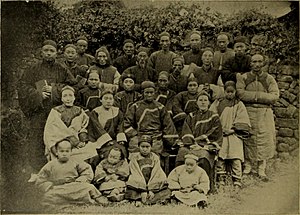
Hakka forms a language group of varieties of Chinese, spoken natively by the Hakka people throughout Southern China and Taiwan and throughout the diaspora areas of East Asia, Southeast Asia and in overseas Chinese communities around the world.

Southern Min, Minnan or Banlam, is a group of linguistically similar and historically related Sinitic languages that form a branch of Min Chinese spoken in Fujian, most of Taiwan, Eastern Guangdong, Hainan, and Southern Zhejiang. Southern Min dialects are also spoken by descendants of emigrants from these areas in diaspora, most notably in Southeast Asia, such as Singapore, Malaysia, the Philippines, Indonesia, Brunei, Southern Thailand, Myanmar, Cambodia, Southern and Central Vietnam, San Francisco, Los Angeles and New York City. Minnan is the most widely-spoken branch of Min, with approximately 48 million speakers as of 2017–2018.

There are hundreds of local Chinese language varieties, forming a branch of the Sino-Tibetan language family, many of which are not mutually intelligible. Variation is particularly strong in the more mountainous southeast part of mainland China. The varieties are typically classified into several groups: Mandarin, Wu, Min, Xiang, Gan, Hakka and Yue, though some varieties remain unclassified. These groups are neither clades nor individual languages defined by mutual intelligibility, but reflect common phonological developments from Middle Chinese.
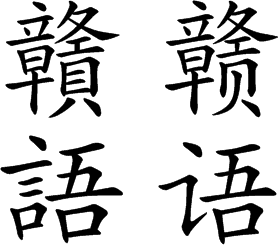
Gan,Gann or Kan is a group of Sinitic languages spoken natively by many people in the Jiangxi province of China, as well as significant populations in surrounding regions such as Hunan, Hubei, Anhui, and Fujian. Gan is a member of the Sinitic languages of the Sino-Tibetan language family, and Hakka is the closest Chinese variety to Gan in terms of phonetics.
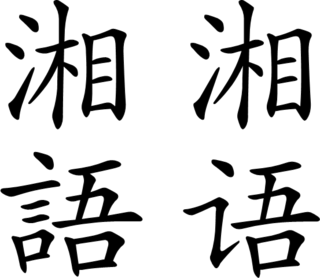
Xiang or Hsiang, also known as Hunanese, is a group of linguistically similar and historically related Sinitic languages, spoken mainly in Hunan province but also in northern Guangxi and parts of neighboring Guizhou, Guangdong, Sichuan, Jiangxi and Hubei provinces. Scholars divided Xiang into five subgroups, Chang-Yi, Lou-Shao, Hengzhou, Chen-Xu and Yong-Quan. Among those, Lou-shao, also known as Old Xiang, still exhibits the three-way distinction of Middle Chinese obstruents, preserving the voiced stops, fricatives, and affricates. Xiang has also been heavily influenced by Mandarin, which adjoins three of the four sides of the Xiang speaking territory, and Gan in Jiangxi Province, from where a large population immigrated to Hunan during the Ming dynasty.
The Han Chinese people can be defined into subgroups based on linguistic, cultural, ethnic, genetic, and regional features. The terminology used in Mandarin to describe the groups is: "minxi", used in mainland China or "zuqun", used in Taiwan. No Han subgroup is recognized as one of People's Republic of China's 56 official ethnic groups.

Eastern Min or Min Dong is a branch of the Min group of the Sinitic languages of China. The prestige form and most commonly cited representative form is the Fuzhou dialect, the speech of the capital of Fujian.
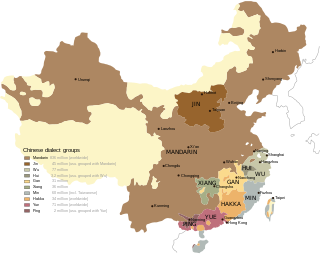
The Sinitic languages, often synonymous with "Chinese languages", are a group of East Asian analytic languages that constitute a major branch of the Sino-Tibetan language family. It is frequently proposed that there is a primary split between the Sinitic languages and the rest of the family. This view is rejected by a number of researchers but has found phylogenetic support among others. The Greater Bai languages, whose classification is difficult, may be an offshoot of Old Chinese and thus Sinitic; otherwise Sinitic is defined only by the many varieties of Chinese unified by a shared historical background, and usage of the term "Sinitic" may reflect the linguistic view that Chinese constitutes a family of distinct languages, rather than variants of a single language.

Sichuanese or Szechwanese (simplified Chinese: 四川话; traditional Chinese: 四川話; Sichuanese Pinyin: Si4cuan1hua4; pinyin: Sìchuānhuà; Wade–Giles: Szŭ4-ch'uan1-hua4), also called Sichuanese/Szechwanese Mandarin (simplified Chinese: 四川官话; traditional Chinese: 四川官話; pinyin: Sìchuān Guānhuà), is a branch of Southwestern Mandarin spoken mainly in Sichuan and Chongqing, which was part of Sichuan Province until 1997, and the adjacent regions of their neighboring provinces, such as Hubei, Guizhou, Yunnan, Hunan and Shaanxi. Although "Sichuanese" is often synonymous with the Chengdu-Chongqing dialect, there is still a great amount of diversity among the Sichuanese dialects, some of which are mutually unintelligible with each other. In addition, because Sichuanese is the lingua franca in Sichuan, Chongqing and part of Tibet, it is also used by many Tibetan, Yi, Qiang and other ethnic minority groups as a second language.
Chang-Du or Chang-Jing, sometimes called Nanchang after its principal dialect, is one of the Gan Chinese languages. It is named after Nanchang and Duchang County, and is spoken in those areas as well as in Xinjian, Anyi, Yongxiu, De'an, Xingzi, Hukou, and bordering regions in Jiangxi and in Pingjiang County, Hunan.
The history of Gan Chinese, a variety of Chinese spoken in modern-day China, stretches back to the beginning of the Qin dynasty. This long stretch of time is divided into Old Gan, late Old Gan, and Middle Gan periods.
Differing literary and colloquial readings for certain Chinese characters are a common feature of many Chinese varieties, and the reading distinctions for these linguistic doublets often typify a dialect group. Literary readings are usually used in loanwords, names, literary works, and in formal settings, while colloquial/vernacular readings are usually used in everyday vernacular speech.

Lower Yangtze Mandarin is one of the most divergent and least mutually-intelligible of the Mandarin languages, as it neighbours the Wu, Hui, and Gan groups of Sinitic languages. It is also known as Jiang–Huai Mandarin, named after the Yangtze (Jiang) and Huai Rivers. Lower Yangtze is distinguished from most other Mandarin varieties by the retention of a final glottal stop in words that ended in a stop consonant in Middle Chinese.
The Wuhua dialect is a major dialect of Hakka Chinese spoken in Wuhua County, Jiexi County, Shenzhen, eastern Dongguan, Northern Guangdong around Shaoguan, Sichuan Province, and Tonggu County in Jiangxi Province.
The Language Atlas of China, published in two parts in 1987 and 1989, maps the distribution of both the varieties of Chinese and minority languages of China. It was a collaborative effort by the Australian Academy of the Humanities and the Chinese Academy of Social Sciences, published simultaneously in the original Chinese and in English translation. Endymion Wilkinson rated this joint venture "outstanding".
The Waxiang people are an unrecognized ethnic group living along the Yuan River in Yuanling County of western Hunan, China. They call themselves Huaxiang people and they speak Waxiang Chinese. Compared to the Han, Miao and Tujia people of the region, they are very different in terms of clothing, food, living, farming and other cultural norms.
Shehua is an unclassified Sinitic language spoken by the She people of Southeastern China. It is also called Shanha, San-hak (山哈) or Shanhahua (山哈话). Shehua speakers are located mainly in Fujian and Zhejiang provinces of Southeastern China, with smaller numbers of speakers in a few locations of Jiangxi, Guangdong and Anhui provinces.
The Hailu dialect, also known as the Hoiluk dialect or Hailu Hakka, is a dialect of Hakka Chinese that originated in Shanwei, Guangdong. It is also the second most common dialect of Hakka spoken in Taiwan.
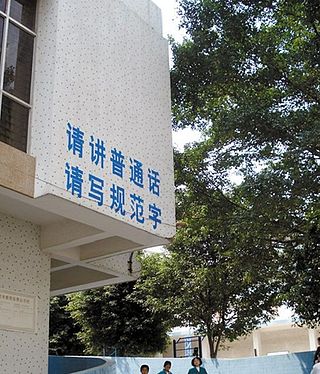
Protection of the varieties of Chinese refers to efforts to protect the continued existence of the varieties of Chinese in Mainland China and other places against pressure to abandon these languages and use Standard Chinese. The Ministry of Education of the People's Republic of China has proclaimed to be taking active measures to protect ten varieties of Chinese. However, a large majority of the citizens of China speak a dialect of Mandarin Chinese, a standardized form of which has been enforced and promoted by the government of China for the last sixty years. The Constitution of the People's Republic of China calls on the government to promote Putonghua as the common tongue of the nation, but this policy has caused conflict to a certain extent with plans to preserve local varieties of Chinese. Education and media programming in varieties of Chinese other than Mandarin have been discouraged by the governments of the People's Republic of China, Singapore, and Taiwan. Teaching the varieties of Chinese to non-native speakers is discouraged by the laws of the People's Republic of China in favor of Putonghua. The Guangdong National Language Regulations are a set of laws enacted by the Guangdong provincial government in the People's Republic of China in 2012 to promote the use of Standard Mandarin Chinese in broadcast and print media at the expense of the local standard Cantonese and other related dialects. It has also been labelled a "pro-Mandarin, anti-Yue" legislation.
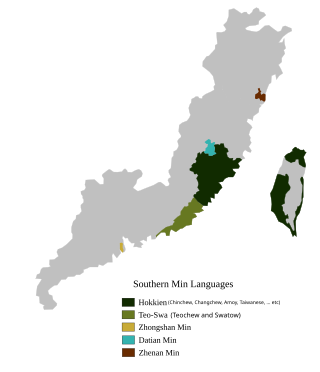
Chaoshan or Teo-Swa is a Southern Min language spoken by the Chaoshan people of the Chaoshan region of eastern Guangdong province, China, and by their diaspora around the world. It is closely related to Hokkien, with which it shares some cognates and phonology, and the two are mutually intelligible.
